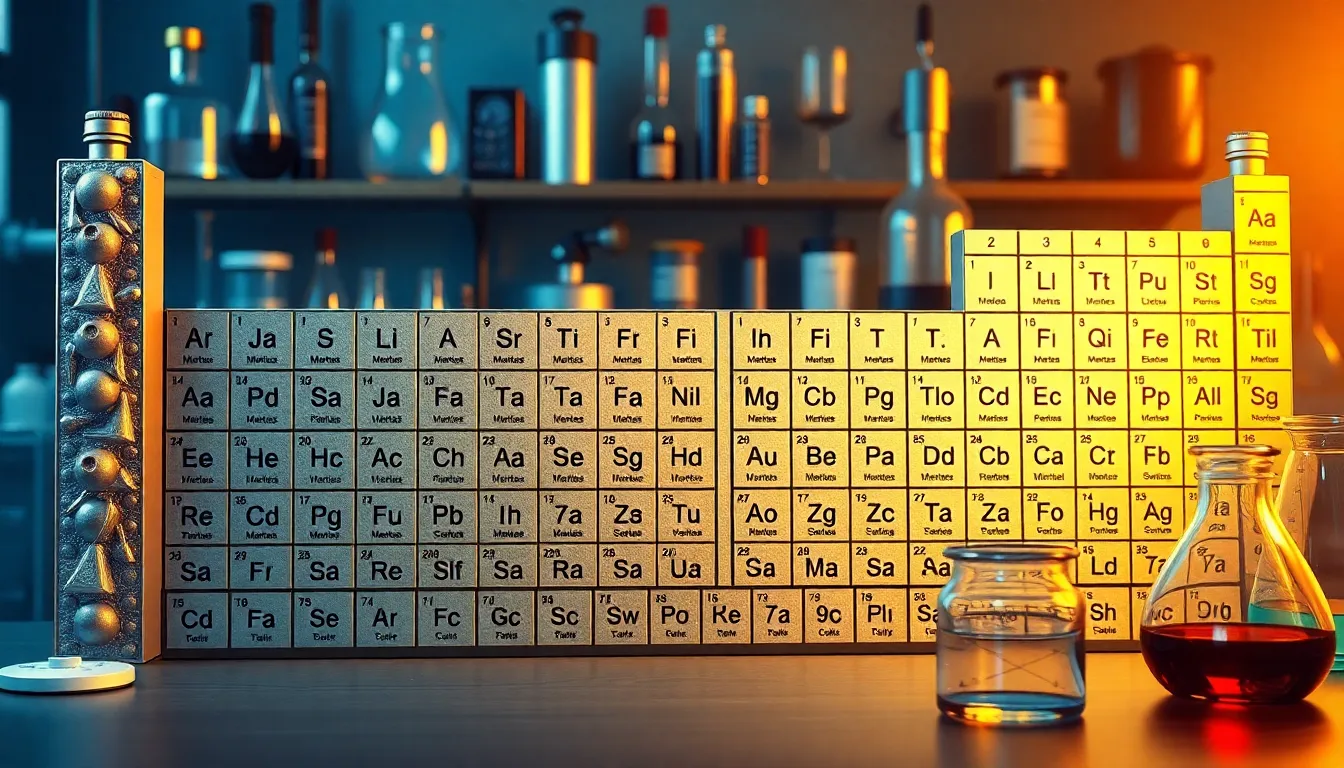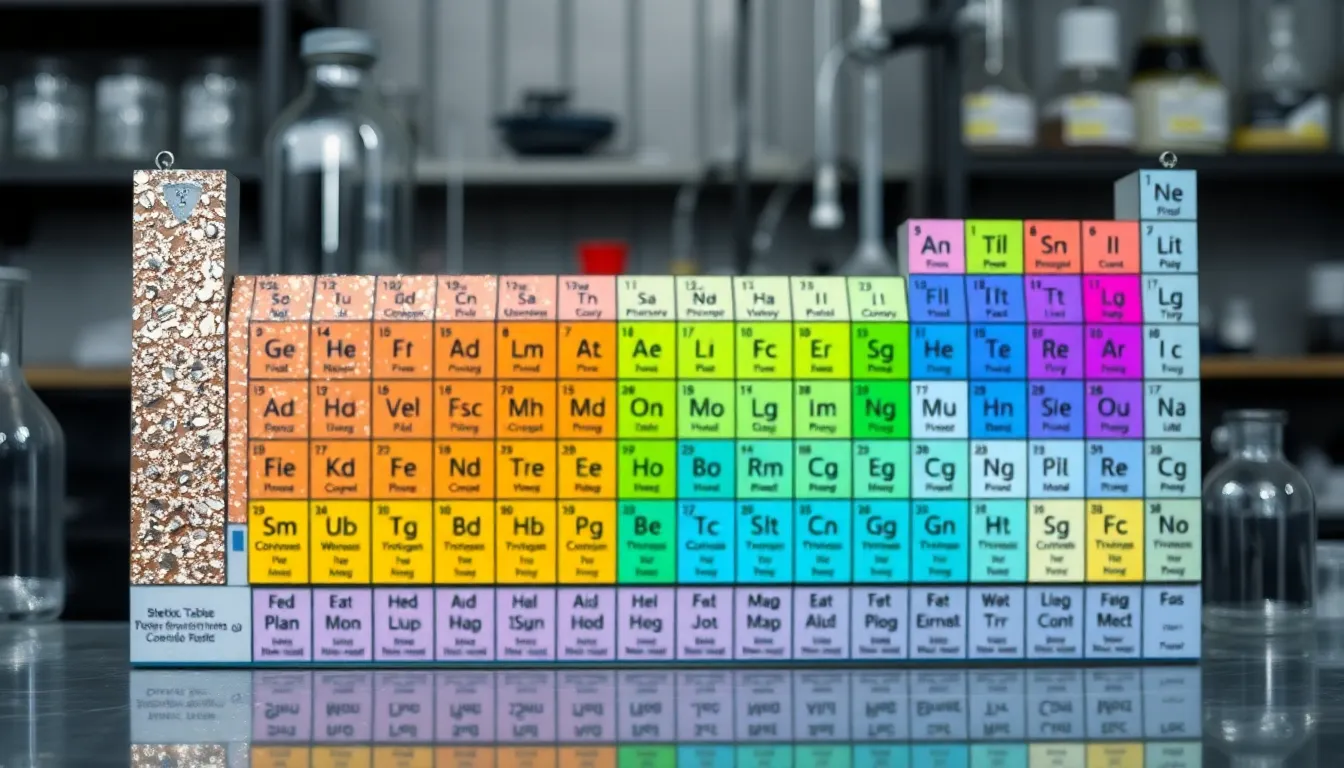Table of Contents
ToggleThe periodic table is more than just a chart; it’s a roadmap to understanding the elements that make up our world. Within its organized layout, metals, nonmetals, and metalloids each play distinct roles in chemistry and everyday life. From the shiny metals that conduct electricity to the nonmetals that form the basis of life, this table reveals the diversity of matter.
Exploring the periodic table’s sections unveils fascinating insights into how these elements interact. Metals dominate the left side, showcasing their properties like conductivity and malleability. Nonmetals, found on the right, present a stark contrast with their varied states and essential roles in biological processes. Metalloids, nestled between, bridge the gap, exhibiting properties of both categories. Understanding these classifications not only enhances knowledge but also sparks curiosity about the fundamental building blocks of everything around us.
Overview of the Periodic Table
The periodic table serves as an essential framework for understanding elements and their relationships. It organizes elements based on atomic number, electron configuration, and recurring chemical properties. Each element’s position reveals vital information about its properties and reactivity.
Metals occupy the left side of the periodic table, exhibiting high conductivity and malleability. Specific examples include iron, copper, and aluminum, known for their strength and utility in various applications. These elements typically lose electrons during chemical reactions, forming positively charged ions.
Nonmetals, found on the right side, play crucial roles in biological processes. Elements such as oxygen, carbon, and nitrogen are fundamental to life. These elements gain or share electrons, forming negatively charged ions or covalent bonds.
Metalloids, situated between metals and nonmetals, display mixed properties. Elements like silicon, germanium, and arsenic exhibit characteristics of both categories. These elements are often semiconductors, making them vital in electronic applications.
Understanding the classifications of metals, nonmetals, and metalloids enhances knowledge about matter and its interactions, illustrating the diverse nature of elements within the periodic table.
Metals in the Periodic Table

Metals occupy the left side of the periodic table and are known for their distinctive properties, which include high conductivity and malleability. These elements play significant roles in various industrial applications.
Characteristics of Metals
- Conductivity: Metals exhibit high electrical and thermal conductivity, allowing them to effectively transfer heat and electricity. Examples include copper and aluminum.
- Malleability: Metals can be deformed or shaped without breaking, making them suitable for manufacturing and construction. Gold and silver are prime examples.
- Ductility: Metals can be drawn into wires. For instance, copper is often used in electrical wiring due to its excellent ductility.
- Luster: Metals have a shiny appearance. Metals like gold and platinum possess a distinct luster that makes them desirable in jewelry.
- Density: Metals usually have high densities. For example, lead and gold are denser than most nonmetals.
- Reactivity: Many metals react with oxygen and acids. Sodium and potassium, for instance, react vigorously with water.
Common Metals and Their Uses
| Metal | Uses |
|---|---|
| Iron | Construction, automotive components |
| Copper | Electrical wiring, plumbing |
| Aluminum | Aircraft manufacturing, packaging materials |
| Zinc | Rust protection, galvanized coatings |
| Lead | Batteries, radiation shielding |
| Silver | Jewelry, electronics, photographic films |
| Gold | Electronics, dental applications, currency |
Metals serve numerous functions across multiple industries, from construction to electronics. Their unique properties enable a wide range of applications, showcasing their importance in nature and technology.
Nonmetals in the Periodic Table
Nonmetals, located on the right side of the periodic table, play crucial roles in various biological and chemical processes. These elements exhibit distinct properties that differentiate them from metals and metalloids.
Characteristics of Nonmetals
Nonmetals exhibit unique characteristics, including:
- Poor conductivity: Nonmetals generally lack electrical and thermal conductivity.
- Brittleness: Most nonmetals exist as brittle solids or gases, shattering rather than deforming under stress.
- Variable states: Nonmetals occur in various states at room temperature, such as gases (oxygen and nitrogen), solids (sulfur and phosphorus), and liquids (bromine).
- Low density: Nonmetals typically possess lower densities compared to metals.
- High ionization energy: Nonmetals have greater ionization energies, making it more challenging to remove electrons.
- Electronegativity: Nonmetals tend to exhibit high electronegativity values, attracting electrons in chemical reactions.
Common Nonmetals and Their Uses
Several common nonmetals are essential for life and technology, including:
- Oxygen (O): Vital for respiration in living organisms and used in water purification processes.
- Carbon (C): The backbone of organic chemistry, found in fuels, plastics, and all known life forms.
- Nitrogen (N): Comprises 78% of Earth’s atmosphere and crucial for the formation of amino acids and proteins.
- Sulfur (S): Utilized in the manufacture of fertilizers, sulfates, and as a key component in certain amino acids.
- Phosphorus (P): Essential for energy transfer in cells through ATP, and vital for DNA and RNA structure.
- Chlorine (Cl): Widely used in sanitation, water treatment, and as a bleaching agent in various applications.
Understanding the properties and functions of nonmetals enhances awareness of their importance in both natural processes and industrial applications.
Metalloids in the Periodic Table
Metalloids occupy a unique position in the periodic table, displaying a mix of properties characteristic of both metals and nonmetals. Their versatile behavior enables significant applications across various industries.
Characteristics of Metalloids
Metalloids exhibit distinct characteristics that bridge the gap between metals and nonmetals.
- Semiconductivity: Metalloids like silicon and germanium demonstrate variable electrical conductivity, making them essential for electronic devices.
- Brittleness: Unlike metals, many metalloids are brittle, which limits their applications in some structural contexts.
- Luster: Metalloids often possess a metallic luster, enhancing their visual appeal and usability in various applications.
- Variable Reactivity: Reactivity among metalloids varies with conditions; some may behave more like metals while others resemble nonmetals.
- Alloys: Many metalloids readily form alloys with metals, enhancing properties such as strength and corrosion resistance.
Common Metalloids and Their Uses
Several metalloids play crucial roles in numerous sectors.
- Silicon: Widely used in electronics, computer chips, and solar cells due to its semiconducting properties.
- Germanium: Utilized in fiber optics and infrared optics for its semiconductor capabilities.
- Arsenic: Employed in glass production and as a doping agent in semiconductors to improve electrical conductivity.
- Boron: Used in glass manufacturing, detergents, and as a semiconductor in certain applications.
- Antimony: Strengthens alloys and is key in flame retardants and semiconductor applications.
These metalloids illustrate diverse applications and underscore their significance in technology and industry.
Significance of Metals, Nonmetals, and Metalloids
Metals, nonmetals, and metalloids play crucial roles in various aspects of science, technology, and everyday life.
Metals are commonly used in construction due to their strength and durability. Iron, copper, and aluminum illustrate this, serving as foundational materials for infrastructure, electrical wiring, and machinery. Metals’ ability to conduct electricity and heat efficiently enables advancements in technology, making them essential for electrical devices and thermal equipment.
Nonmetals are significant for life processes. Oxygen, carbon, and nitrogen are fundamental to biological systems, participating in respiration, organic chemistry, and amino acid synthesis. Nonmetals’ unique properties, like high ionization energy and electronegativity, make them vital for forming compounds that sustain living organisms and drive industrial processes.
Metalloids bridge the gap between metals and nonmetals, conferring them unique advantages in technology. Silicon and germanium, for instance, are pivotal in semiconductor applications, enabling the functionality of modern electronics. Their varied reactivity and properties allow them to function effectively in diverse applications, such as solar cells and glass production.
Understanding the significance of these elements enhances insight into their collective impact on technological progress and biological processes, emphasizing their integral roles in the periodic table.
The periodic table serves as a vital resource for understanding the elements that shape the world. Metals, nonmetals, and metalloids each play distinct roles that contribute to various scientific and industrial advancements. Their unique properties not only define their behaviors in chemical reactions but also influence their applications in everyday life.
From the strength of metals in construction to the essential functions of nonmetals in biological systems and the innovative uses of metalloids in technology, these elements collectively enhance our comprehension of matter. This knowledge fosters curiosity and appreciation for the intricate relationships between different types of elements, highlighting their importance in both nature and human innovation.






